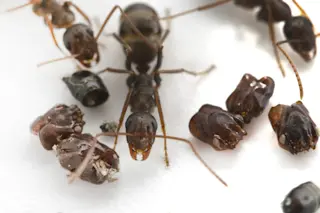This article was originally published on Nov. 16, 2018.
For 60 years, scientists observing Formica archboldi, a species of ant native to Florida, have documented something…odd. The ants’ underground nests are littered with skulls and other body parts, primarily of Odontomachus, trap-jaw ants. Trap-jaws are formidable predatory badasses. F. archboldi are not. So what’s going on? A new study sorts out the mystery — but discovers an even bigger oddity.
[Update for the TL;DR crowd: The skull-collecting ants appear to be trap-jaw ant prey specialists, which is unusual. They appear to have more effective techniques for immobilizing the trap-jaws. Once immobilized, they take the trap-jaws back to their nests and dismember them, treating them as prey. They do not eat the heads, so the heads are left behind. That’s not nearly the most interesting thing the researcher reported in the study, but whatevs.]
Of the 15,000 or so ant species ...














